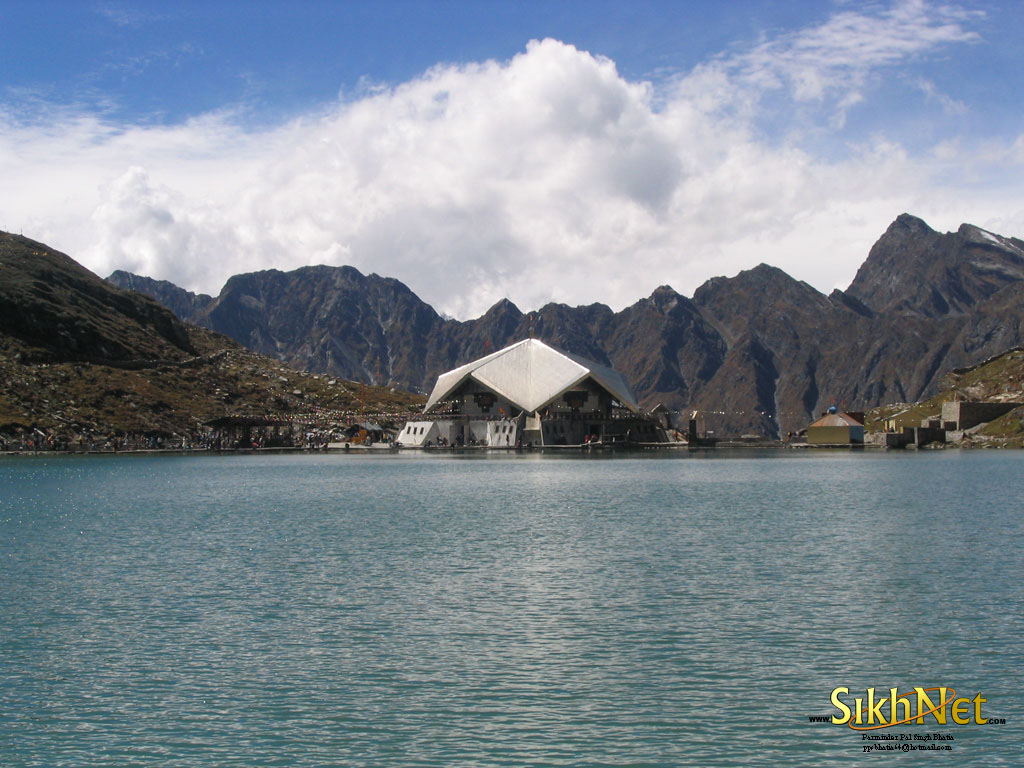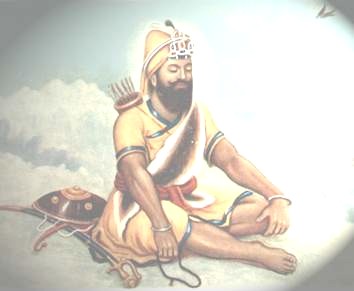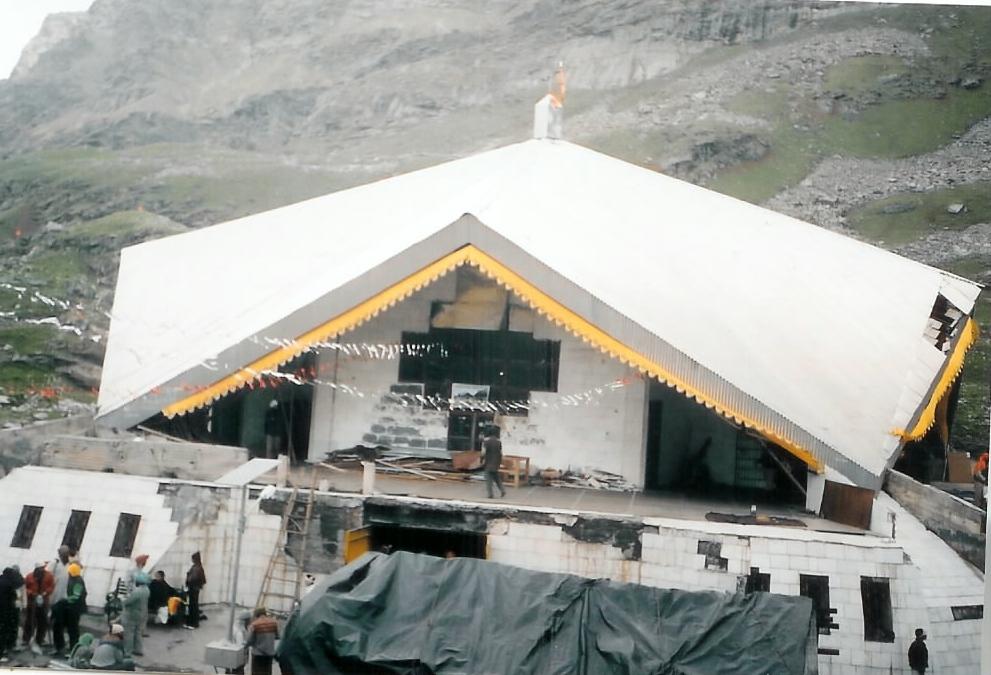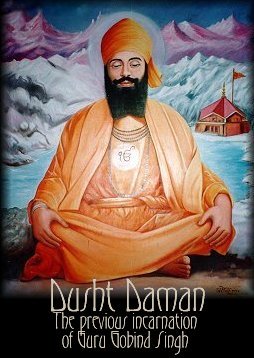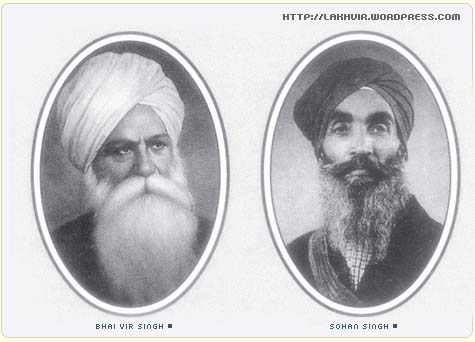Gurdwara Hemkunt sahib
Gurdwara Hemkunt Sahib (coordinates ) is a Sikh shrine present in Uttarakhand state in India at a place called Lokpal, which is now associated with the tenth Guru, Guru Gobind Singh.
However, what distinguishes it from other historical sites linked to the great Guru is that this site is connected to the Guru's previous incarnation as the mighty warrior, Dusht Daman. According to some interpretations, the tenth Sikh Guru mentions this place in his composition Bachitar Natak which is found in the Dasam Granth, the second most important scripture of the Sikhs. But it was not until the twentieth century after many long years of searching that Hemkunt Sahib was finally discovered or (re-discovered).
In the Indian epic and Puranic literature, Himalayan landscapes are described as the dwelling places of gods and goddesses. Pilgrimage shrines mark the places where the landforms themselves - mountains, rivers, forests, and lakes - are said to have acquired sacred qualities. High above the tree line, in the midst of a natural rock garden of moss, ferns, and flowers, is one such sacred place: a small, blue-green lake fed by water which cascades down from the surrounding mountain walls.
Background
Located in the Uttarkhand Himalayas bordering Tibet and Nepal, it is accessible only between June and October when the sun and monsoon rains melt the ice and snow that are its namesake. Then, the steep stone footpath that leads to the lake is crowded with pilgrims and tourists. They journey to the base of the route on foot from neighbouring mountain valleys, or from the plains in buses, cars, and trucks, on scooters and bicycles, even by foot. Then for two days they climb upward. Some walk, some ride mules, and some are carried by porters.
Finally, at the top of more than a thousand stone steps, the holy lake, the Sri Hemkunt Sahib Gurdwara, and the Sri Lakshman Mandir come into view. High in the snow capped mountains of the Himalayas this site has been hidden from sight for eons. For thousands of years this place has remained unknown to humans, a place of utter beauty and peaceful serenity. Here a natural lake lies on a plateau at a height of 15,000 feet surrounded by seven snow clad peaks. To the Sikhs this place is known a Hemkunt Sahib.
Before this site was discovered by the Sikhs it was known locally as Lokpal, which translates to ‘protector of the world’. Long a place of worship and pilgrimage by the local Hindu population, a place linked to the hindu trinity of the creator – Brahma, the sustainer – Vishnu and the destroyer – Shiva. The Vedas and Purana texts of ancient India mention the Himalayas as the abode of the gods and goddesses, the locals tell a modified version of the Ramayana which actually is cast in far off Lanka (Sri Lanka). tales of Lakshman, Vishu and Hanuman.
In the historic version Lakshman the brother of Rama is mortally wounded in battle while he is leading Hanuman's army of Monkeys against some demons sent by Raavana the villianous Demon Ruler of Lanka who has stolen Sita the wife of Rama. To save the fallen hero the Hindu God Hanuman jumps all the way from Lanka (Sri Lanka) to the Himalayas to get a rare plant that will save Lakhsmans life.
In the local version Lakhsman, was brought to the shores of this lake by his wife. Here she prayed to Hanuman the (Vanara) or monkey god to save Lakhsman's life. Hanuman heard her prayers and found the life giving herb called Sanjivani Bhutti, this was given to Lakshman and he was revived. The gods were overjoyed and went to Lord Bramha to give thanks, seek his blessing and protection from the demons who ravaged the world. In their version the myth of Hanuman and Lakhsman has been blended with Sikhi to include Guru Nanak and Guru Gobind Singh, whereby Lord Brahma told them that only Nanak the 'saviour of the universe' can assist them in his tenth incarnation, in which, the tales relate, he will destroy evil and tyranny and will become the protector of the holy people.
Detailed History
Sikhs believe that this holy place, known as Hemkunt (lake of ice/lit. cut in the snow), is the tap asthan (place of meditation and prayer) at which the tenth and final living Guru of the Sikhs achieved union with God in his previous incarnation. From there, the Guru was summoned by God to be reborn into the world to teach the people the true path. The temple built on the shore of the lake commemorates his mission. It also shelters the Guru Granth Sahib, the eternal scriptural Guru for the Sikh community. The community is itself recognized as a collective Guru, and pilgrims, as they walk the path toward Hemkunt, share the sacred journey with its members.
In this way, all three forms of the Guru - the source of spiritual guidance - are understood to be present at Hemkunt. Sikh pilgrims go there to be inspired to walk the same difficult path that the Guru walked, both in body and in spirit, and to, through the Guru's grace, realize their connection with God in the same place where the Guru realized his. At Hemkunt Sahib, Sikhs feel closer to the Guru and, through the Guru, closer to God. Gurudwara Hemkunt in the Himalayas is also regarded as one of the holiest places of the Sikhs. It was there that Sri Guru Gobind Singh the tenth and last Guru of the Sikhs is reported to have meditated in his previous life.
Bachitar Natak
In 'Bachitar Natak' the great Guru relates his story which is interpreted as - "I shall now relate my own story, how God sent me into this world. I was busy performing penance on the hills of 'Hemkunt' where seven peaks are prominent. The place is called 'Sapt Shring’ where King Pandu had performed Yoga, there I practised austerity and worshipped the god of death."
The Guru's previous life
About his own life Guru Gobind Singh writes in his auto-biography as under: -
| ਅਬ ਮੈ ਅਪਨੀ ਕਥਾ ਬਖਾਨੋ ॥ ਤਪ ਸਾਧਤ ਜਿਹ ਬਿਧਿ ਮਹਿ ਆਨੋ ॥ |
| Ab main apnee katha bakhaano. Tap saadhat iih bidh muhe aano. |
| Now I relate my own story as to how I was brought here. While I was absorbed in deep meditation. |
| ਹੇਮ ਕੰਟ ਪਰਬਤ ਹੈ ਜਹਾਂ ॥ ਸਪਤ ਸਰਿੰਗ ਸੋਭਿਤ ਹੈ ਤਹਾਂ ॥੧॥ |
| Hemkunt Parbat hai jahaan, Sapt sring sobhit hai tahaan .1. |
| The site was the mountain named Hemkunt, with seven peaks and looks there very impressive .1. |
| ਸਪਤ ਸਰਿੰਗ ਤਿਹ ਨਾਮ ਕਹਾਵਾ ॥ ਪੰਡ ਰਾਜ ਜਹ ਜੋਗ ਕਮਾਵਾ ॥ |
| Satptsring teh naam kahawa. Pand raaj jahan jog kamava |
| That mountain is called Sapt Shring (seven-peaked mountain), where the Pandavas Practised Yoga. |
| ਤਹ ਹਮ ਅਧਿਕ ਤਪਸਿਆ ਸਾਧੀ ॥ ਮਹਾਕਾਲ ਕਾਲਿਕਾ ਅਰਾਧੀ ॥੨॥ |
| teh ham adhik tapasaya sadhi. mahakaal akalka aradhi .2. |
| There I was absorbed in deep meditation on the Primal Power, the Supreme Being .2. |
The Guru Ji tells us about his previous incarnation, that in the Himalayan range, where there is Sapt Sring Mountain, on that hill he meditated the Name of God.
In his meditation when he became one with God, then the Almighty ordained him to take birth in India in order to crush the cruel rulers. "My father and mother meditated on the incomprehensible. They both practiced the highest yoga through diverse spiritual efforts. Their devout service in the love of God pleased the Almighty who commanded me to take human form in this world. I did not like to come. God sent me into the world with a mandate saying, 'I cherish thee as my son and send thee to establish the path of truth. Go into the world and establish virtue and keep the people, away from evil.'When my father came to Triveni (Allahabad) he daily devoted himself to meditation and charity. There at Allahabad the dazzling light manifested itself into human form."
| ਇਹ ਬਿਧਿ ਕਰਤ ਤਪਿਸਆ ਭਯੋ ॥ ਦਵੈ ਤੇ ਝਕ ਰੂਪ ਹਵੈ ਗਯੋ ॥ |
| Ih bidh karat tappsaya bhayo. Davai te ek roop havai gayo. |
| In this way, my meditation reached its zenith and I became One with the Omnipotent Lord. |
| ਤਾਤ ਮਾਤ ਮਰ ਅਲਖ ਅਰਾਧਾ ॥ ਬਹ ਬਿਧਿ ਜੋਗ ਸਾਧਨਾ ਸਾਧਾ ॥੩॥ |
| taat maat mur alakh araahaa. bahu beedh jog saahdna sahdaa ॥3॥ |
| My parents also meditated for the union with the Incomprehensible Lord and performed many types of disciplines for union.3. |
| ਤਿਨ ਜੋ ਕਰੀ ਅਲਖ ਕੀ ਸੇਵਾ ॥ ਤਾ ਤੇ ਭਝ ਪਰਸੰਨਿ ਗਰਦੇਵਾ ॥ |
| tin jo karee alakh kee sevaa. taa tay bhaay prasanni gurdava ॥ |
| The service that they rendered the Incomprehensible Lord, caused the pleasure of the Supreme Guru (i.e. Lord). |
| ਤਿਨ ਪਰਭ ਜਬ ਆਇਸ ਮਹਿ ਦੀਆ ॥ ਤਬ ਹਮ ਜਨਮ ਕਲੂ ਮਹਿ ਲੀਆ ॥੪॥ |
| tin prabh jab aaees muh theeaa. tab hamm janam kaloo mahi leeaa ॥4॥ |
| When the Lord ordered me, I was born in this Iron age.4. |
| ਚਿਤ ਨ ਭਯੋ ਹਮਰੋ ਆਵਨ ਕਹਿ ॥ ਚਭੀ ਰਹੀ ਸਰਤਿ ਪਰਭ ਚਰਨਨ ਮਹਿ ॥ |
| Chit na bhayo hamro aavan kaih. Chubhi rahee srut Prabhu chaman maih |
| I had no desire to come, because I was totally absorbed in devotion for the Holy feet of the Lord. |
| ਜਿਉ ਤਿਉ ਪਰਭ ਹਮ ਕੋ ਸਮਝਾਯੋ ॥ ਇਮ ਕਿਹ ਕੈ ਇਹ ਲੋਕਿ ਪਠਾਯੋ ॥੫॥ |
| Jio tio Prabh ham ko samjhaayo. Im Kaih kai ih lok Pathaayo. |
| But the Lord made me understand His Will and sent me in this world with the following words.5. |
The Guru was so much engrossed in the Name of God, that he did not want to take re-birth. But somehow the Almighty, persuaded him and he was born at Patna Sahib. His mother was Mata Gujri and his father was ninth Sikh Guru, Guru Tegh Bahadar.
As Guru Gobind Singh had mentioned, the place of his previous incarnation in his auto-biography, many Sikh scholars tried very hard to locate the exact place. In this field the names of Bhai Vir Singh, Sant Sohan Singh, Hawaidar Mohan Singh, Sant Thandi Singh and Sant Surat Singh are prominent as they played an important part in the discovery of Hemkunt sahib. They dedicated their whole life to locate the exact place in order to construct the Gurdwara Hemkunt Sahib. In this field the services of the Hem Kunt-Trust are laudable. The Trust has constructed roads leading towards Hemkunt Sahib and for the benefit of the travellers it has built big Gurdwaras on the way.
Dusht Daman
From Bachitar Natak Composition is proves authenticity of Hemkunt Sahib and Guru Gobind Singh's do had treaty with Akal Purakh for starting a Panth but there is no mention of Dushat Daman in any composition of Tenth Nanak in Dasam Granth.
According to a Traditional Sikh Mythology and Local Culture, During the age of truth – Sat Yuga, gods and mortals will face the tyranny of the fierce demons known as Dhents. The gods will call upon Durga Devi to assist them and she will do battle against the dhents. The onslaught will be too much even for her and she will flee to the mountains. Here she will approach a holy man called Samaundh Rikhi who will be seated upon a lions skin. She will ask for his help. The pursuing demons will also reach his abode and demand that the rishi tell them where she is. The rikhi says that since the devi has sought his protection he is duty bound to assist her. The demons are enraged by this and draw their swords. The rishi addresses them " I am a Brahmin and will therefore not take up arms against you, but I will create a Khattri (warrior class) who will be known as Dusht Daman (destroyer of evil) who will destroy you and your kin". He then rises and shakes the lion skin, from this emerges shakti (power) in the form of a Khattri warrior carrying a sword. The warrior asks permission to engage in battle with the dhents. When this is given the battle ensues. The battles last for many years and in the end all the dhents are destroyed by Dusht Daman. The warrior then returns to the rikhi and says "what are your orders now ?" The rikhi tells the youth that he is to go to the mountains and perform intense penance and austerities. Dusht Daman sets of and reaches the lake of Hemkunt Sahib and spends many many years meditating on the name of the one true God. So much tapasia (meditation on Gods name) is done that the two – Dusht Daman and God – become one.
Discovery Of Hemkunt Sahib
- Main article: Discovery of Hemkunt sahib
Sant Sohan Singh wanted to spread the news of his discovery but none wanted to heard it, it fell on deaf ears. The Gurdwara committee of Musourie the closest town to Uttarkhand were very skeptical, as were the Sharomani Gurdwara Parbandakh Committee, nobody would listen. He then decided to contact Bhai Vir Singh Ji. In 1934 Sohan Singh met Bhai Vir Singh and convinced him that he had found Hemkunt Sahib.
Bhai Vir Singh offered his help to develop the site of Hemkunt Sahib. He gave Sohan Singh funds to buy material and construct a Gurdwara on the shores of the lake. Sohan Singh was accompanied by a Havaldar (army sergeant) called Modan Singh who had offered his services. A year later both of them set off again. They got a local building contractor to start construction of the gurdwara after obtaining local permission. Out of respect for the Hindu mandir that stood on the shores of the lake, it was also enlarged and improved. Such was the devotion of Modan Singh that after retiring from the army he dedicated his life to the service of Hemkunt Sahib.
In the early days there was no shelter on route to Hemkunt Sahib and Moden Singh would shelter from the fierce wind and cold weather in a hollowed out tree trunk. This tree trunk still stands in the grounds of the gurdwara of Gobind Dham. Today there is a string of gurdwaras from Hardwar to Rishkesh, Srinagar, Joshimat, Gobind Ghat and Gobind Dham where devotees can rest for food and shelter.
This 'lake of ice' is also sacred to the hill people who live in the valley below. They tell of the gods Lakshman, Hanuman, Shiva, and Vishnu, the tales of their deeds woven together with images from local landscapes. Long before the Sikhs knew the lake as the Guru's tap asthan, these people knew it as Lokpal, and made annual pilgrimages to its shore. For them, as for Sikhs, the journey continues to be an act of devotion, and the holy lake itself is a place for prayer and worship - a place where wishes can be fulfilled.
External links
Photos
| JOURNEY SHRI HEMKUNT SAHIB |
ROUTE 1 - Haridwar ROUTE 2 - Paonta Sahib Rishi Kesh ♣♣ Dev prayag ♣♣ Srinagar ♣♣ Rudra Prayag ♣♣ Karna prayag ♣♣ Nanda prayag ♣♣ Joshi Math ♣♣ Vishnu prayag ♣♣ Gurudwara Gobind ghat ♣♣ Gurudwara Gobind Dham ♣♣ Hemkunt Sahib |
